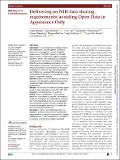| dc.contributor.author | Watson, Hope | |
| dc.contributor.author | Gallifant, Jack | |
| dc.contributor.author | Lai, Yuan | |
| dc.contributor.author | Radunsky, Alexander P. | |
| dc.contributor.author | Villanueva, Cleva | |
| dc.contributor.author | Martinez, Nicole | |
| dc.contributor.author | Gichoya, Judy | |
| dc.contributor.author | Huynh, Uyen Kim | |
| dc.contributor.author | Celi, Leo Anthony | |
| dc.date.accessioned | 2024-02-12T20:12:28Z | |
| dc.date.available | 2024-02-12T20:12:28Z | |
| dc.date.issued | 2023 | |
| dc.identifier.issn | 2632-1009 | |
| dc.identifier.uri | https://hdl.handle.net/1721.1/153503 | |
| dc.description.abstract | Introduction
In January, the National Institutes of Health (NIH) implemented a Data Management and Sharing Policy aiming to leverage data collected during NIH-funded research. The COVID-19 pandemic illustrated that this practice is equally vital for augmenting patient research. In addition, data sharing acts as a necessary safeguard against the introduction of analytical biases. While the pandemic provided an opportunity to curtail critical research issues such as reproducibility and validity through data sharing, this did not materialise in practice and became an example of ‘Open Data in Appearance Only’ (ODIAO). Here, we define ODIAO as the intent of data sharing without the occurrence of actual data sharing (eg, material or digital data transfers).
Objective
Propose a framework that states the main risks associated with data sharing, systematically present risk mitigation strategies and provide examples through a healthcare lens.
Methods
This framework was informed by critical aspects of both the Open Data Institute and the NIH’s 2023 Data Management and Sharing Policy plan guidelines.
Results
Through our examination of legal, technical, reputational and commercial categories, we find barriers to data sharing ranging from misinterpretation of General Data Privacy Rule to lack of technical personnel able to execute large data transfers. From this, we deduce that at numerous touchpoints, data sharing is presently too disincentivised to become the norm.
Conclusion
In order to move towards Open Data, we propose the creation of mechanisms for incentivisation, beginning with recentring data sharing on patient benefits, additional clauses in grant requirements and committees to encourage adherence to data reporting practices. | en_US |
| dc.language.iso | en_US | |
| dc.publisher | BMJ | en_US |
| dc.relation.isversionof | 10.1136/bmjhci-2023-100771 | en_US |
| dc.rights | Creative Commons Attribution | en_US |
| dc.rights | An error occurred on the license name. | * |
| dc.rights.uri | https://creativecommons.org/licenses/by/4.0/ | en_US |
| dc.source | BMJ | en_US |
| dc.title | Delivering on NIH data sharing requirements: avoiding Open Data in Appearance Only | en_US |
| dc.type | Article | en_US |
| dc.identifier.citation | Watson H, Gallifant J, Lai Y, et al. Delivering on NIH data sharing requirements: avoiding Open Data in Appearance Only. BMJ Health Care Inform 2023;30:e100771. | en_US |
| dc.contributor.department | Harvard--MIT Program in Health Sciences and Technology. Laboratory for Computational Physiology | |
| dc.contributor.department | Harvard University--MIT Division of Health Sciences and Technology | |
| dc.relation.journal | BMJ Health & Care Informatics Online | en_US |
| dc.eprint.version | Final published version | en_US |
| dc.type.uri | http://purl.org/eprint/type/JournalArticle | en_US |
| eprint.status | http://purl.org/eprint/status/PeerReviewed | en_US |
| dspace.date.submission | 2024-02-12T20:08:51Z | |
| mit.journal.volume | 30 | en_US |
| mit.journal.issue | 1 | en_US |
| mit.license | PUBLISHER_CC | |
| mit.metadata.status | Authority Work and Publication Information Needed | en_US |
